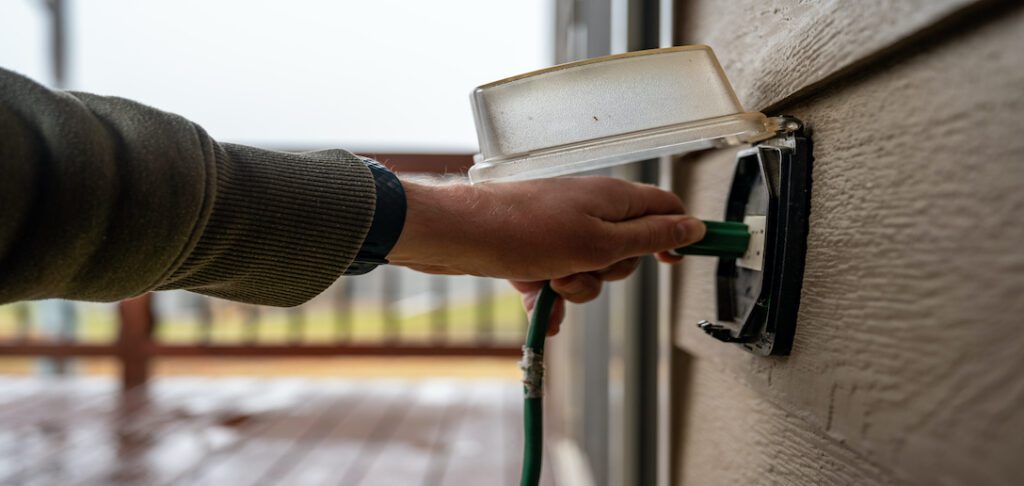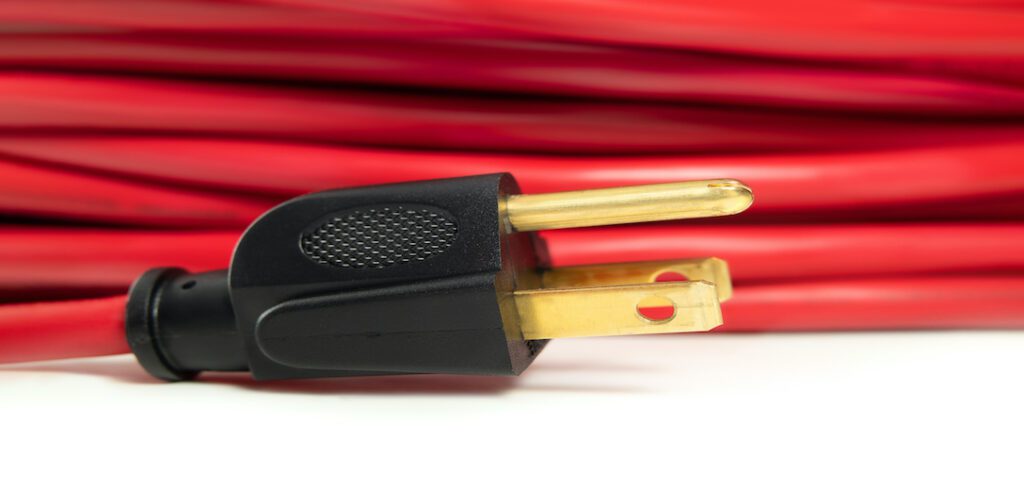Outdoor extension cords are convenient for areas where access to power sources may be limited. This short-term solution can be used to power your Christmas lights, keep a bounce house running during your child’s birthday party, or help you with projects that require power tools. Of course, there are certain risks involved—so knowing how to use extension cords safely is critical for preventing fires and keeping your home safe.
4-Star Electric provides comprehensive electrical safety inspections in Calgary, so we know all about how to safely use outdoor extension cords. Here’s our list of safety tips to help you use these cables responsibly, plus advice on how to set up permanent outdoor electrical wiring if you need it.
Choosing the Right Extension Cord
The first thing you need to do before using an extension cord is make sure you’re using the right type. Indoor extension cords should not be used outside and vice versa.
You also need to consider the right length and gauge, based on the power needs and distance from your power source. Here are some things to look for:
- Consider cords that are approved by an independent testing lab, like Underwriters Laboratories (UL).
- Check the cord’s instructions about the correct use and the amount of power it draws.
- A cord’s gauge indicates its size. Smaller numbers have a larger wire, meaning the cord can safely handle a larger electrical current.
- Longer cords can’t handle as much electrical current as shorter cords of the same gauge.
- Thick, round, low-gauge extension cords are best for larger appliances. Use a thin or flat cord for smaller appliances.
- Choose cords with polarized or three-prong plugs.
Proper Placement
Once you’ve chosen the appropriate extension cord for your outdoor needs, you’ll need to find the best place to put the cords while in use.
- If possible, try to run the extension cord through an area where there’s not a lot of foot traffic.
- Stay away from walkways and areas where your children or pets play often to avoid tripping accidents.
- You should also avoid placing an extension cord near water or heat sources.
When you’re ready to plug in your extension cord, be sure the plug is pushed in all the way. You shouldn’t be able to see any part of the plug prongs if plugged in properly.
Weatherproofing
Another reason why it’s important to use an outdoor-only extension cord outside is because many are designed to withstand various weather conditions like moisture, rain, snow, freezing temperatures and sunlight. These cords have added shielding layers to insulate and protect the fragile wires inside. You can also invest in weatherproof covers for connections.
If possible, try to keep your cords elevated to prevent water or snow damage and keep it as dry as possible. A wet extension cord could cause a short in your electrical device, leading to an electric shock or fire.
Avoiding Overloads
As mentioned before, it’s super important to pay attention to your extension cord’s gauge level to know how much power the cord can handle. To avoid an overload of power, only connect a device with a power draw within the cord’s capacity. It’s also best to use only one extension cord per power supply versus a multi-plug extension cord.
Inspect for Damage
It’s extremely important to check over your outdoor extension cord before plugging it in. Regular inspections are vital; check for signs of wear and tear, fraying or damage like a broken prong.
If you notice your cord is damaged, throw it away and replace it immediately. Don’t try to splice the cord or use electrical tape to repair or patch up an exposed wire. You should also discard an extension cord that feels hot to the touch to prevent an electrical hazard.
If you’re using cords in an area where they can risk becoming damaged, consider running underground electrical wiring instead. This is a more permanent solution that also avoids many of the safety risks associated with damaged extension cords.

Using GFCI Outlets
Another way to protect your outdoor extension cord is to ensure the outlet outside your home is safe to use. We highly recommend using a Ground Fault Circuit Interrupter (GFCI) outlet for outdoor use. These safety outlets provide an extra layer of protection against electrical shocks and short circuits, especially in damp or wet areas. The GFCI tracks the amount of electric current flowing through the circuit. If there’s ever any loss of current it will trip the circuit.
To check if your outlets are GFCI certified, look for a small, pushable button on each of your outdoor outlets. These buttons allow you to reset the receptacle and it’s a good idea to test the button first to make sure it’s working before plugging your extension cord into the outlet.
See Also:How Does a GFCI Work (& Where Do You Need Them in Your Home?)
Unplugging After Use
Just like any electrical device, your outdoor extension cord should be unplugged when not in use. Leaving your cords plugged in unnecessarily increases the risk of damage and potential hazards.
When you’re ready to unplug your extension cord, do not pull on the cord when removing it from the outlet. It’s better to grab the head of the extension cord plug and pull from there to avoid damaging the cord.
Safe Storage
It’s also super important to safely store your extension cord when you’re not using it. To avoid damage, store your extension cord in a cool, dry place—indoors, if possible, like in the garage. Coil them loosely to avoid kinks and tangles that could lead to damage for next use. This will also improve the lifespan of your cords. When it’s time to use your cord again, check for signs of any damage before plugging it in.
Avoiding Daisy Chains
One thing you should definitely avoid with your outdoor extension cords is daisy chaining: connecting multiple extension cords together in a series. This can lead to overheating and poses a serious fire hazard, not to mention a tripping hazard as well.
As mentioned before, be sure to use a single cord for each electrical need and find one that’s the appropriate gauge size and length.
Abiding by Local Regulations
Finally, be sure that all of your outdoor extension cords adhere to local regulations and codes for outdoor electrical use. Compliance helps ensure the safety of your home and yourself. If you’re not sure whether you’re breaking city rules, contact our team and book an inspection so that we can verify the safety and legality of your setup.
No matter what you’re using an outdoor extension cord for, we hope these safety tips are top of mind during your next use. Remember to use the appropriate length and gauge size for outdoor use only, avoid placing the cord near walkways and heat or water sources to prevent fire or tripping hazards, properly store your cords when not in use, and avoid using damaged cords.
Get Connected with the 4-Star Electric Team
It’s key to note that outdoor extension cords are intended as a temporary wiring solution. If you’re using them on a permanent basis, consider updating your home’s electrical system.
We can help with that! Our team of experts offer outdoor electrical installations and inspections that protect your safety and liability. Just contact 4-Star Electric to have us answer any questions or concerns you have, or browse our most frequently asked questions about extension cords below.

Frequently Asked Questions About Outdoor Extension Cords
How Do I Know if My Extension Cord is Outdoor Rated?
The letter “W” is typically included on the packaging or cord to indicate that it’s used for outdoor use. Outdoor extension cords typically have a bright orange, vinyl or plastic covering on it that protects against moisture and weather conditions.
How Long Will an Extension Cord Last Outside?
Outdoor extension cords are used for short-term power supply, meaning a job that should only take a day or two. Here are some examples of how you can use an outdoor extension cord:
- Trimming your bushes with a pole saw
- Powering a bounce house for your kid’s birthday party
- Provide lighting for an outdoor event or gathering
- Keeping your Christmas lights on at night
What is the Best Gauge For an Outdoor Extension Cord?
The safest gauge options for any outdoor use are 14, 12 and 10. A 14-gauge is better for smaller outdoor appliances like a leaf blower, while a 12 or 10-gauge is used for heavy duty or high-powered appliances. A higher gauge may also be needed for longer-term outdoor use that goes beyond a few hours.
Do Outdoor Extension Cords Need to be Covered?
It’s highly recommended that you cover your extension cord for more protection. A cover will keep the wires safe from water, humidity, dirt and lawn debris.
When Should I Replace My Outdoor Extension Cord?
An outdoor extension cord should be replaced once you see apparent damage like frayed or damaged wires, loose plugs, and cracking or peeling insulation.


